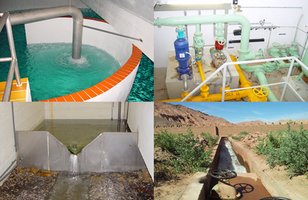Wind Monitoring
Wind speed and direction are crucial parameters for just about all applications that ADCON is covering. As with most sensors a variety of different technologies serve the market from different angles, be that measurement range, accuracy, robustness, energy consumption or price. ADCON provides a selection for all sorts of applications.
Measuring the wind really is a challenging enterprise. Depending on application it needs to be monitored at 2m and/or 10m above the ground, sometimes even at up to 80m above the ground. While for some applications accuracy at top wind speeds is crucial (e.g. wind energy assessment), for other applications accuracy at low speeds and a very low onset speed are required (e.g. to calculate Evapotranspiration).
Power consumption is always of concern. If customers want to monitor wind according to the WMO standard as defined in the 7th edition of the CIMO guide, a reading needs to be taken every 250ms, and that requires the sensor to be permanently powered. For a properly built sensor using a very low-power magnetic hall sensor this is no problem, let alone those employing a generator, which, by definition, doesn’t consume any power at all, in contrast, it is even generating power for its analogue output signal. What adds to that is the additional requirement to calculate an average of 12 readings every 250ms for proper wind gust determination, so the logger also needs to be powered permanently in order to perform this task.
Ultrasonic sensors are called state of the art, but it is frequently overlooked that these sensors, while having lower on-set speeds and usually higher accuracy, also consume significantly more power, particularly if operated in WMO-mode. In freezing conditions surface moisture can easily freeze over and block the emitters, so heating is recommended. An advantage of mechanical sensors, which go largely unaffected by a little bit of freezing water on the cups or vanes.
Robustness often is an underestimated requirement. Cups turning in winds of over 100km per hour are subject to significant forces. Add cold temperature to that, making plastic brittle and susceptible to damage, add a few twigs, branches or other objects inevitably flying around at high wind speeds, and such an unfortunate cup or vane is quickly snapped, subsequently only too often also damaging the bearings due the unbalanced rotation.
ADCON has closely looked at all of the above and can offer a broad range of sensors to address these issues.
For most agricultural and meteorological applications we deploy two types of mechanical sensors. Both are made of extremely robust aluminium, have very low onset-speeds, high accuracy and an extremely low power consumption. To find out more about these sensors, click on these links:
Of course both sensor sets are fully compatible to the Adcon A753 RTUs. Both versions, UHF and GPRS/UMTS, feature a special WMO-compliant wind port. Once connected to this port, with the "wind gust feature" properly activated, the RTU will take four readings per second, calculate and store a 12-sample average every 250ms, and finally transmit the highest such wind gust per measurement period, together with an arithmetic average wind speed.
For customers that prefer to work with ultrasonic sensors we deploy the WS series of compact sensors, as developed and built by our sister company Lufft of Germany. These sensors are available in a variety of combinations, with or without additional integrated parameters, with or without heating. You can find all about these sensors on the Lufft website. These sensors, in contrast to the two mechanical sensor sets above, which have analogue output signals, use digital SDI-12 ports. Therefore the sensors can be connected to any ADCON RTU featuring an SDI-12 port.













